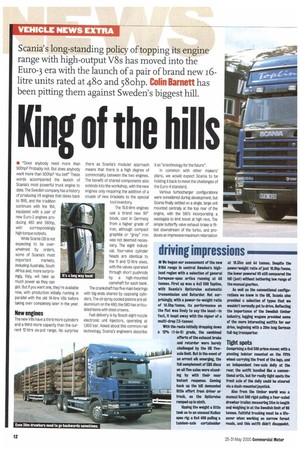driving impressions
Page 14

Page 15

If you've noticed an error in this article please click here to report it so we can fix it.
• We began our assessment of the new R164 range in central Sweden's highland region with a selection of general European-spec artics running at 40 tonnes. First up was a 4x2 580 Topline, with Scania's Opt icruise automatic transmission and Retarder. Not surprisingly, with a power-to-weight ratio of 14.5hp/tonne, its performance on the flat was lively to say the least—in fact, it leapt away with the vigour of a multi-drop 7.5-tonner.
With the route initially dropping down a 12% (1-in-8) grade, the combined efforts of the exhaust brake and retarder were barely challenged by the UK fiveaxle limit. But in the event of an errant elk emerging, the full complement of EBS discs on all five axles were standing by with their near instant response. Coming back up the hill demanded little effort from driver or truck, as the Opticruise romped up in ninth.
Upping the weight a little took us to an unusual Italian spec rig: a 6x4 480 pulling a tandem-axle curtainsider at 18.35m and 44 tonnes. Despite the power/weight ratio of just 10.9hp/tonne, the lower powered V8 still conquered the hill (Just) without bothering low range of the manual gearbox.
As well as the conventional configurations we know in the UK, Scania also provided a selection of types that we wouldn't normally get to drive. Reflecting the importance of the Swedish timber industry, logging wagons provided some of the more interesting outfits for our drive, beginning with a 20m long German full-log transporter.
Tight spots
Comprising a 6x4 580 prime mover, with a pivoting bolster mounted on the fifth wheel carrying the front of the logs, and an independent two-axle dolly at the rear, the outfit handled like a conventional artic, but for really tight spots the front axle of the dolly could be steered via a dash-mounted joystick.
Also from the timber world was a manual 6x4 580 rigid pulling a four-axled drawbar trailer, measuring 24m in length and Weighing in at the Swedish limit of 60 tonnes. Faithful tracking must be a lifesaver when working on narrow forest roads, and this outfit didn't disappoint
No retarder was fitted, but the exhaust brake coped well with the task, with just the occasional dab on the 14 discs keeping things In check down the hill.
We suffered a minor problem coming back up—at the steepest point a too hasty change into low range left a box of neutrals and no forward progress. But with composure regained and first norma] gear engaged the 580 horses pulled us away again with absolutely no drama, proving just why Scania makes the big V8.
Sweden's maximum length for a 60tonner is 25.25m (that's a whisker under 83 feet for those of us who still think in old money). Special Types rules apart, this represents the ultimate in European "turn up and drive" trucking, and we sampled the concept in the shape of a Norwegian-spec B-double rig. The 580hp 6x2 tractive unit hauls a radical semitrailer fitted with a fifth wheel at the rear, which in turn pulls another (conventional) semi-trailer.
Our spell at the wheel got off to a worrying start when its minder suggested that we should reverse down the road to give a wider swing into the truck stop to turn around. We managed around 20m in a straight(-ish) line, but any precision manoeuvring would need plenty of practice on a convenient airfield with no spectators, Fortunately it tracked remarkably well in tight spots with much less cut-in than expected, all nine axles following pretty much the same route. The turning point of our route was located in a small car park with a large tourist notice board, complete with shingle roof, in the middle. With a turning circle little more than the length of the second trailer, the B-double negotiated this hazard with ease.
In fact, the only vehicle to strike the roof was one of the conventional artics (not driven by a British journalist, we should add!)
Open road
On the open road. the B-double was remarkably stable and easy to drive, although the view in the rear-view mirror was reminiscent of a scene from Great Railway Journeys of tire World The only hiccup on the run came when another driver, who had taken the controls for the return journey, tried to outsmart the Opticruise in semi-auto mode but ran out of steam on the steepest part of the hill.
Once again the restart was dramafree, but reminded us that if the technology's available, maybe it's best to use it.
















































































































